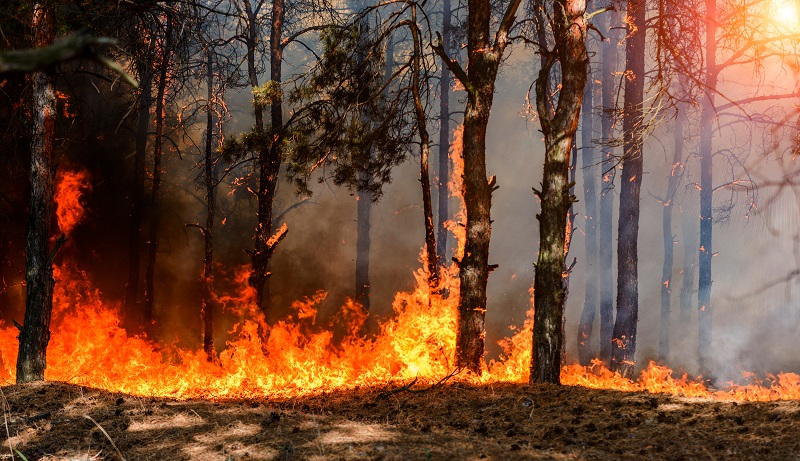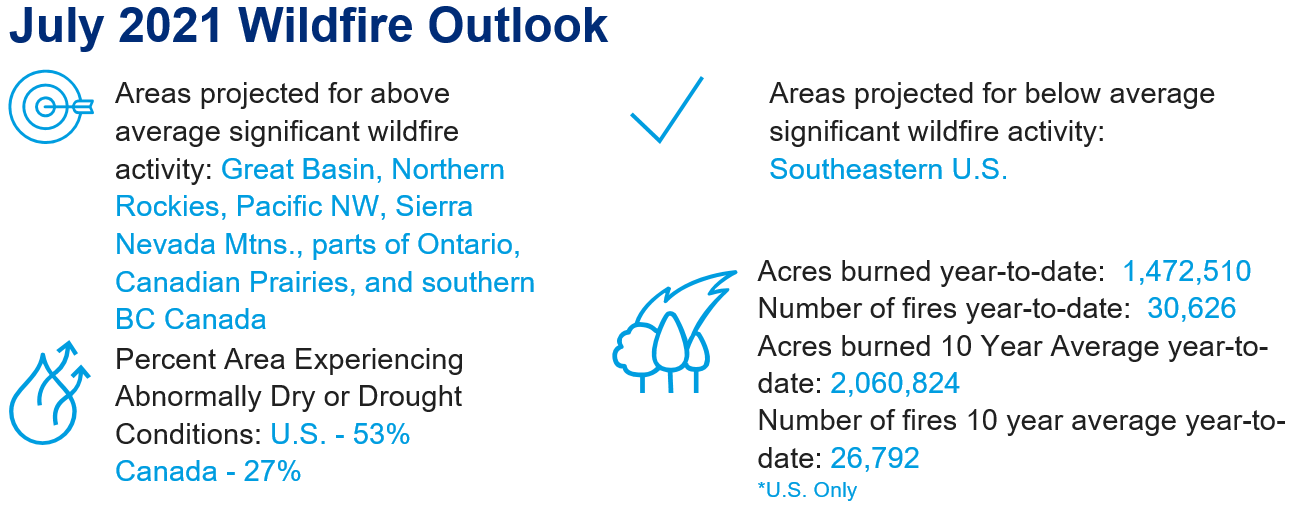

Key Headlines
- Current Fire Activity Increasing: Fire activity increased significantly across the West during June. Most of the fire activity was in the Southwest, Colorado, Utah, and Montana through mid-June, coincident with the area of most extreme drought. New and large fires were reported in California and Oregon as record heat set in in the Pacific NW. The majority of structures in the town of Lytton, British Columbia burned in a wildfire on Wednesday, a day after the town recorded the country's highest temperature in history (121F).
- Historic drought conditions are affecting much of the western U.S.: Upwards of 68% of the western U.S. is in some state of drought moving into July. Drought conditions are easing in the hard hit Four Corners region with the on-set of the seasonal monsoon, while conditions are worsening in the Northern U.S. and Canada due to record high temperatures.
- Drought affected areas to experience elevated temperatures and below average precipitation in the coming months: The seasonal monsoon has finally arrived in the southwest, however concern is shifting north, where below average precipitation is expected over the summer. This, coupled with above average temperatures, is leading to a worsening drought and a heightened risk for wildfire activity.
Unprecedented Drought Grips Western U.S.
- Exceptional Drought Conditions: Exceptional drought is the highest drought classification and is covering nearly 17% of land area in the western United States. The area hardest hit is west of the Rocky Mountains in the Four Corners Region. There are additional pockets of exceptional drought in the Northern Plains, California and Oregon.
- Dry Fuels: Fuel moisture, which is the best indicator of the current vulnerability of the landscape to both fire ignition and spread, is very low in some regions of the Western US due to a persistent lack of precipitation and above average temperatures in the spring and early summer. Even very large fuels that require many weeks of adverse conditions to dry out (known as 1000 hour fuels) have fuel moisture contents of under 5% in portions of Nevada, Utah, Arizona and California. This region is currently experiencing a significant amount of wildfire activity, however it has not impacted people or property extensively to date.
- Record heat: The Pacific NW and British Columbia are experiencing record heat, with many locations experiencing the highest recorded temperatures in history over the past weekend. When the temperature is high, the atmosphere can hold more water vapor. As a consequence, water rapidly evaporates off of the soil, the vegetation and water bodies. This period of extremely high temperatures is worsening the already present drought conditions.

United States Drought Monitor. Source: USDA / NOAA.

Canada Drought Monitor. Source: Minister of Agriculture, Canada

The western US has been characterized by below average precipitation over the past 60 days. Source: High Plains Regional Climate Center

The western US has been characterized by above average temperatures (4-8 degrees) in the late spring and summer. Source: High Plains Regional Climate Center

1000 Hour Fuel Dryness; indicating fuel moisture content of under 5% in portions of the southwest US. Source: USFS.
Summer Outlook
- Above average potential for much of the western U.S. and parts of Canada: The combination of above average temperature and below average precipitation over the summer months is expected to worsen drought conditions, with fuels rapidly drying out across northern tier states in the US, as well as southern BC and the Prairie Provinces of Canada.
- Summer Wildfire Activity: The National Interagency Fire Center's Predictive Services branch is indicating Above Normal Significant Wildland Fire Potential in the Pacific NW, the intermountain West, the Northern Great Plains, and portions of California. Additionally, Environment Canada is also forecasting a well above average wildfire severity anomaly in Manitoba, with above average anomalies stretching along the southern border from British Columbia to Ontario.

Above average temperatures are forecast across much of the US for the next three months. Source: NOAA.

Below average precipitation is forecast for the northwest United States into the Rockies for the next three months. Much of the eastern U.S. can expect above average precipitation over the same period. Source: NOAA.
NIFC Wildland Fire Potential Outlook for the next 4 months. Source: Predictive Services

Canada Wildfire Forecast Severity Anomaly. Source: Environment Canada
Additional links of interest:
U.S. Department of Agriculture Drought Monitor
National Interagency Fire Center